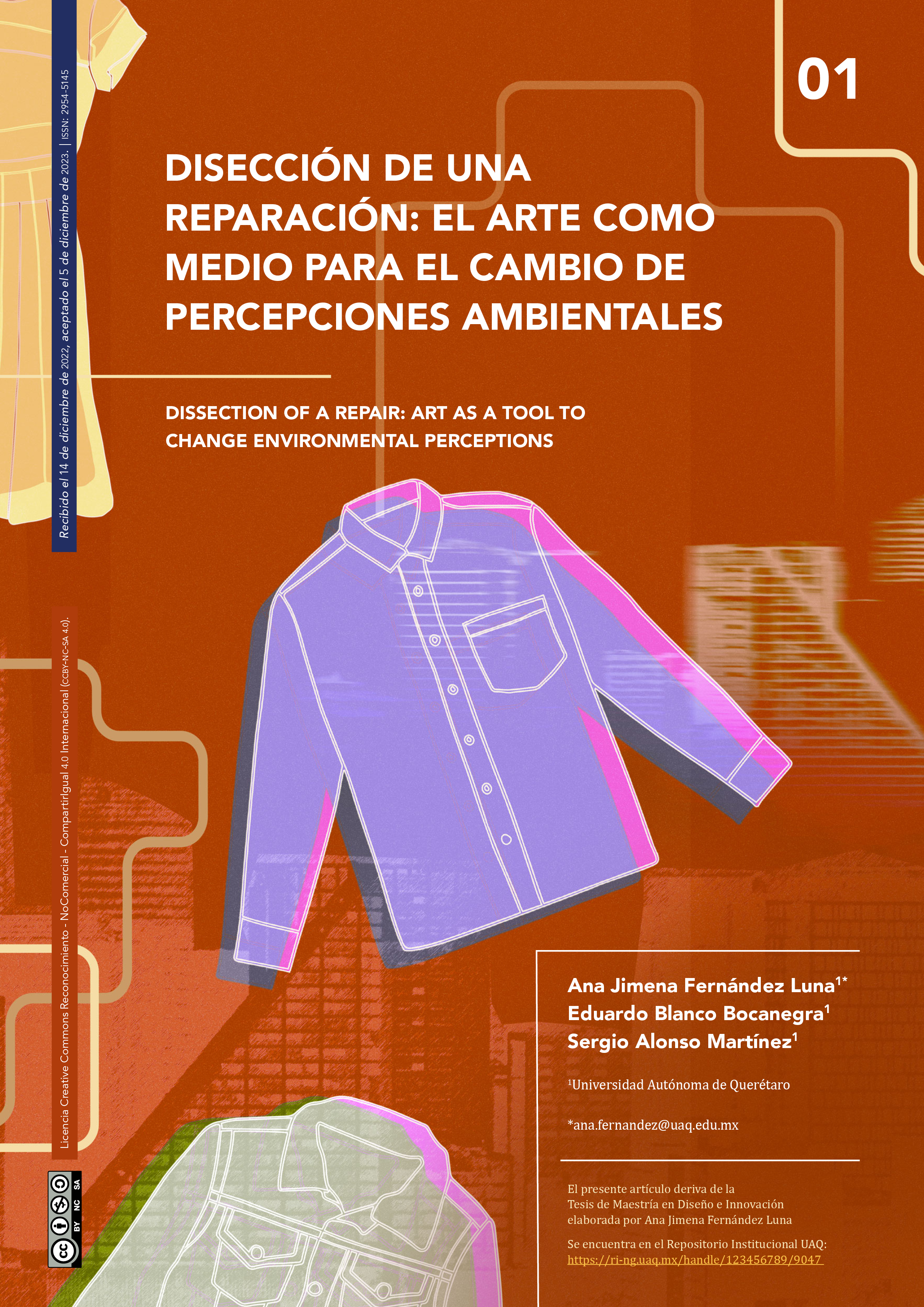Abstract
The new textile production techniques aimed at reducing costs and time have resulted in a wide range of products that evolve rapidly with current trends. In turn, consumers have intensified this phenomenon, leading to an excess of textiles in the world. Fletcher (2012) emphasizes the importance of consumers in extending the life of textile products through conservation and usage practices. Thus, it is relevant to generate knowledge about users’ textile disposal habits to design revaluation strategies that will help reduce textile waste. The present research focuses on discouraging users from dis-carding their textiles through the design and implementation of an artistic intervention that influences the environmental perception of a young population in the city of Querétaro. Art as a means of social intervention provides the opportunity to create emotional connections with the users and, in this case, motivate them to participate in initiatives to address current environmental and social issues.
References
Aladro Vico, E., Jivkova Semova, D. y Bailey, O. (2018). Artivismo: Un nuevo lenguaje educativo para la acción social transformadora tt - Artivism: A new educative language for transformative social action. Comunicar: Revista Científica de Comunicación y Educación, 26(57), 9–18.
Becker Leifhold, C. y Heuer. M. (2018). Eco-Friendly and Fair. doi: https://doi.org/10.4324/ 9781351058353
Binotto, C. y Payne, A. (2017). The Poetics of Waste: Contemporary Fashion Practice in the Context of Wastefulness. Fashion Practice, 9(1), 5–29. doi: https://doi.org/10.1080/17569370.2016.1226604
Centella, V. O. (2015). El artivismo como acción estratégica de nuevas narrativas artistico- políticas. calle14: Revista de investigación en el campo del arte, 10(15), 100-111. doi: https://doi.org/10.14483/ udistrital.jour.c14.2015.1.a08
Corral Chagolla, M. A. (2016). Atrapados en las apariencias. Análisis filosófico del homo consumens en la sociedad de consumo. [Archivo pdf]. https://rei.iteso.mx/bitstream/handle/11117/4054/Tesis Apariencias.pdf?sequence=2%0 Ahttps://rei.iteso.mx/bitstream/handle/11117/4054/Tesis Apariencias.pdf?sequence=2
Curtis, D. J., Reid, N. y Ballard, G. (2012). Communicating ecology through art: What scientists think. Ecology and Society, 17(2). doi: https://doi.org/10.5751/es-04670-170203
Deschamps, T. C., Carnie, B. y Mao, N. (2017). Public consciousness and willingness to embrace ethical consumption of textile products in Mexico. Textiles and Clothing Sustainability, 2(1). doi: https://doi.org/10.1186/s40689-016-0017-2
Diddi, S. y Yan, R. N. (2019). Consumer perceptions related to clothing repair and community mending events: A circular economy perspective. Sustainability, 11(19). doi: https://doi.org/10.3390/su11195306
Durrani, M. (2018). “People gather for stranger things, so why not this?” Learning sustainable sensibilities through communal garment-mending practices. Sustainability, 10(7). doi: https:// doi.org/10.3390/su10072218
Ernantez, E. K. P., Barrera, MMB. y Navacerrada, MA. (2017). Textile Wastes: State of the Art. Journal of Textile Science y Engineering, 07(06), 1-4. doi: https://doi.org/10.4172/ 2165-8064.1000322
Escobar Fuentes, S. y Aguilar Ta- mayo, M. F. (2019). Artivismo en la cultura digital. Dos casos en México: #IlustradoresCon Ayotzinapa y #Noestamos todas. Index, Revista de Arte Contemporáneo, 08, 142-150. doi: https://doi.org/10.26807/cav.v0i08.273
Fernández Luna, A. J. (2023). Estrategia de percepción ambiental para reducir la intención de desecho textil post-consumo. [Tesis de maestría]. https://ri-ng.uaq.mx/handle/123456789/9047
Felshin, N. (1995). But is it art? The Spirit of Art as Activism. Bay Press Inc.
Fletcher, K. (2012). Durability, Fashion. Sustainability: The Processes and Practices of Use. Fashion Practice, 4(2), 221-238. doi: https://doi.org/ 10.2752/175693812x13403765252389
Jacoby, J., Berning, C. K., y Dietvorst, T. F. (1997). What about Disposition? Journal of Marketing, 41(2), 22. doi: https://doi.org/10.2307/1250630
Koch, K., y Domina, T. (1999). Consumer Textile Recycling as a Means of Solid Waste Reduction. Family and Consumer Sciences Research Journal, 28(1), 3-17. doi: https://doi.org/10.1177/1077727x99281001
Koukouvinos, D. (2012). Psychosocial Factors Influencing Young Consumers’ Clothing Disposal Behaviour in Greece. [Tesis de Maestría en Gestión de moda], Universidad de Borås.
Morgan, L. R. y Birtwistle, G. (2009). An investigation of young fashion consumers’ disposal habits. International Journal of Consumer Studies, 33(2), 190-198. doi: https://doi.org/10.1111/j.1470-6431.2009.00756.x
Morlet et al. (2017). A new textiles economy: Redesigning fashion’s future. Ellen MacArthur Foundation, 1-150. https://www.ellenmacarthurfoundation.org/publications/a-new-textiles-economy-redesigning- fashions-future
Neto, A. y Ferreira, J. (2021). “I Still Love Them and Wear Them”–Conflict Ocurrence and Management in Wearer- Clothing Relationships. Sustainability, 13(23). doi: https:// doi.org/10.3390/su132313054
Park, H.-H., Choo, T. G., y Ku, Y. S. (2016). The Influence of Shopping Orientation on Difficulty Discarding and Disposal Behavior of Fashion Products. Fashion & Textile Research Journal, 18(6), 833-843. doi: https://doi.org/10.5805/sfti.2016.18.6.833
Peña García, N. (2014). El valor percibido y la confianza como antecedentes de la intención de compra online: el caso colombiano. Cuadernos de Administración, 30(51), 15-24. doi: https://doi.org/10.25100/cdea.v30i51.39
Rotimi, E. O. O., Topple, C. y Hopkins, J. (2021). Towards a conceptual framework of sustainable practices of post- consumer textile waste at garment end of lifecycle: A systematic literature review approach. Sustainability, 13(5). doi: https://doi.org/10.3390/su13052965
Tedesco, S. y Montacchini, E. (2020). From textile waste to resource: a methodological approach of research and experimentation. Sustain- ability, 12(24), 1–12. doi: https://doi.org/10.3390/su122410667
Tereso, S. (2012). Environmental education through art. International Journal of Education Through Art, 8(1), 23–47. doi: https://doi.org/10.1386/eta.8.1.23_1
Ütebay, B., Çelik, P. y Çay, A. (2016). Textile wastes: status and perspectives. Waste in Textile and Leather Sectors. doi: https://doi.org/10.5772/intechopen.92234
Wai Yee, L., Hassan, S. H. y Ramayah, T. (2016). Sustainability and Philanthropic Awareness in Clothing Disposal Behavior Among Young Malaysian Consumers. sage Open, 6(1). doi: https://doi.org/10.1177/2158244015625327

This work is licensed under a Creative Commons Attribution-NonCommercial-ShareAlike 4.0 International License.
Copyright (c) 2024 SketchIN


